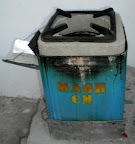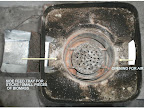



[Magh CM Laxmi [MCL]](http://e-mcl.blogspot.com/ "MAGH CM LAXMI WOODGAS STOVE") is a Natural draft woodgas stove. It is a modification of [Magh CM ](http://e-maghcm.blogspot.com/)for convenience of using all types of Biomass as fuel.
In many villages power is rarely available or available for few hours. In such a situation peoples' priority is for Natural draft stoves as compared to forced air stoves. The control on feeding fuel to the stove is another aspect, which people prefer. And more importantly the community wants freedom regarding the type of fuel to be used. They dont want to have stoves for different types of fuels, as they cannot afford as many stoves as types of fuels.
Magh CM Laxmi evolved from Magh CM. One of the user of Magh CM Ms. Laxmi, Peddamaduru village, has removed the fan and started feeding the sticks from side openings. She is able to use this stove with wood shavings and the sticks. She could use this stove for large scale cooking (12 members), during one of the festivals without any problem.
Keeping in view the adoptation factors and convenience of cooking MCL design is finalized. In honor of Ms. Laxmi the stove is named as [Magh CM Laxmi (MCL)](http://e-mcl.blogspot.com/). By increasing the height of the stove (chimney effect) the soot has been reduced.
Apart from using sticks, it is also convenient to use woodshavings / pieces of wood / leaves / dung balls / dung cakes / pellets / any small pieces of biomass fuel through the elevated side feed tray (its inclination can be controlled for fuel to slide down into the combustion zone).
In both Magh CM and Magh CM Laxmi the design enables the user to control the flames in the stove through primary air control shutter, convenience of removal of biochar. This stove costs about $6. For more information on [[Magh series stoves]](http://www.goodstove.com)
